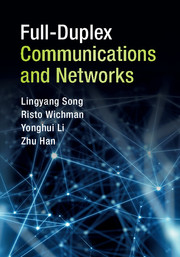Book contents
- Frontmatter
- Dedication
- Contents
- Preface
- 1 Basics of Communication Systems
- 2 Signal Processing and Theoretical Limits
- 3 Full-Duplex System Hardware Implementation
- 4 Full-Duplex MIMO Communications
- 5 Full-Duplex OFDMA Communications
- 6 Full-Duplex Heterogeneous Networks
- 7 Full-Duplex Cooperative Networks
- 8 Full-Duplex Cognitive Radio Networks
- 9 Full-Duplex Random Access Networks
- References
- Index
Preface
Published online by Cambridge University Press: 16 March 2017
- Frontmatter
- Dedication
- Contents
- Preface
- 1 Basics of Communication Systems
- 2 Signal Processing and Theoretical Limits
- 3 Full-Duplex System Hardware Implementation
- 4 Full-Duplex MIMO Communications
- 5 Full-Duplex OFDMA Communications
- 6 Full-Duplex Heterogeneous Networks
- 7 Full-Duplex Cooperative Networks
- 8 Full-Duplex Cognitive Radio Networks
- 9 Full-Duplex Random Access Networks
- References
- Index
Summary
Overview
With more and more new multimedia-rich services being introduced and offered to a rapidly growing population of global subscribers, there is an ever-increasing demand for higher data rate wireless access, making more efficient use of this precious resource a crucial need. As a consequence, new wireless technologies such as Long Term Evolution (LTE) and LTE-Advanced have been introduced. These technologies are capable of providing high-speed, large-capacity, and guaranteed quality-of-service (QoS) mobile services.With the technological evolution of cellular networks, new techniques, such as small cells, have also been developed to further improve the network capacity by effectively reusing the limited radio spectrum. However, all existing wireless communication systems deploy half-duplex (HD) radios which transmit and receive the signals in two separate/orthogonal channels. They dissipate the precious resources by employing either time-division or frequency-division duplexing.
Full-duplex (FD) systems, where a node can send and receive signals at the same time and frequency resources, can offer the potential to double spectral efficiency; however, for many years it has been considered impractical. This is because the signal leakage from the local output to input, referred to as self-interference, may overwhelm the receiver, thus making it impossible to extract the desired signal. How to effectively eliminate self-interference has remained a long-standing challenge. Recently, there has been significant progress in self-interference cancellation in FD systems, which presents great potential for realizing FD communications for the next generation of cellular networks.
This book provides state-of-the-art research on FD communications and cellular networks covering the physical, MAC, network, and application layer perspectives. The book also includes fundamental theories based on which FD communications will be built. In addition to the self-interference cancellation signal processing algorithms, the book discusses physical layer algorithms, radio resource allocation and network protocols in the practical design and implementation of centralized and distributed FD wireless networks. Main applications such as FD cognitive radio networks, FD cooperative networks, and FD heterogeneous networks are explored.
The key features of this book are as follows:
• A unified view of FD communications and networking;
• A comprehensive review of the state-of-the-art research and key technologies of FD communications networks;
• Coverage of a wide range of techniques for design, analysis, optimization, and application of FD communications networks;
• An outline of the key research issues related to FD communications and networking.
Information
- Type
- Chapter
- Information
- Full-Duplex Communications and Networks , pp. xi - xviPublisher: Cambridge University PressPrint publication year: 2017
